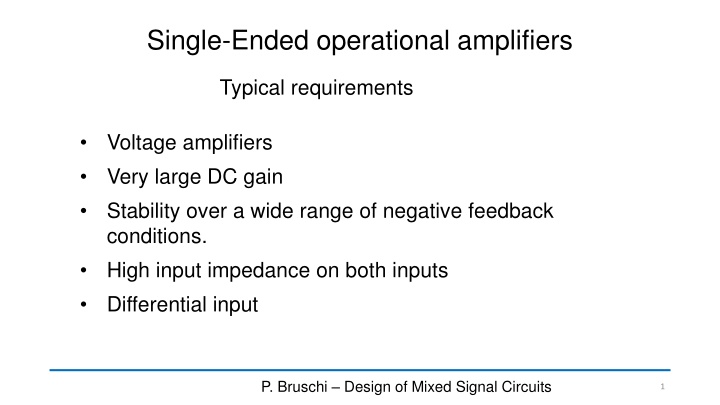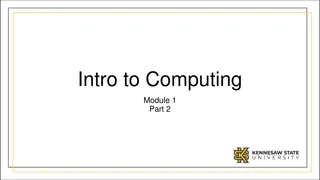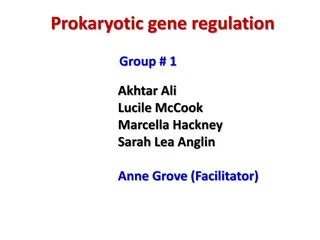
Design Specifications for Single-Ended Operational Amplifiers
Explore the design requirements for single-ended operational amplifiers, including voltage amplification, high input impedance, and stability with negative feedback. Learn about output impedance, amplifier performance in load conditions, and single-supply voltage circuit considerations. Gain insight into output stage specifications, classes, and practical applications in microelectronic system design.
Download Presentation

Please find below an Image/Link to download the presentation.
The content on the website is provided AS IS for your information and personal use only. It may not be sold, licensed, or shared on other websites without obtaining consent from the author. If you encounter any issues during the download, it is possible that the publisher has removed the file from their server.
You are allowed to download the files provided on this website for personal or commercial use, subject to the condition that they are used lawfully. All files are the property of their respective owners.
The content on the website is provided AS IS for your information and personal use only. It may not be sold, licensed, or shared on other websites without obtaining consent from the author.
E N D
Presentation Transcript
Single-Ended operational amplifiers Typical requirements Voltage amplifiers Very large DC gain Stability over a wide range of negative feedback conditions. High input impedance on both inputs Differential input P. Bruschi Design of Mixed Signal Circuits 1
Typical op-amp-based negative feedback loop * v 1 = = + R MAX 1 out v N / / Z Z Z R * * A A + L = A A L s N OL / / Z Z out L This is a design specification P. Bruschi Microelectronic System Design 2
Requirement on the output impedance / / Z Z Z 1 + R MAX + 1 L = A A * A A OL / / Z Z L out L Zoutshould be low enough to guarantee that A is large enough to maintain the relative error below the maximum value allowed in all the expected load conditions load: / / Z Z L P. Bruschi Microelectronic System Design 3
Example ADA4628 (Analog Devices) RL1 A1 A2 RL2 Passing from RL=10k to RL=2 k the amplifier looses around 8 dB R A A R R A R R + = 1 R L 1 OL + 1 L out 6 k R out = A 2 L 2 O L 2 L ou t P. Bruschi Microelectronic System Design 4
Output stages - specifications I I I max max ON Sink out OP Source = = + V V V V V V max out dd H min out ss L P. Bruschi Microelectronic System Design 5
Single supply case In a single supply voltage circuit, the load cannot be connected to gnd (or Vdd) if we want a to impose both positive and negative voltages across it. To achieve this result, the load should be applied across the amplifier output port and a proper constant voltage, typically equal to Vdd/2. This voltage must be generated by a proper cell, starting from Vdd. P. Bruschi Microelectronic System Design 6
Oputput stage classes constant Idev2 By subtracting two unipolar currents, we obtain a bi- directional output current = I I I 1 2 out dev dev P. Bruschi Microelectronic System Design 7
Common source output stages: class-A case Margins to the rails are now only a VDSAT, which is much smaller than a VGS. The common source output stage has a practically rail-to-rail output swing + V DSATn V V V DSATp V ss out dd P. Bruschi Microelectronic System Design 8
Other info on the class-A common source n-version = = + (0) V V v -VGSp in in in I I I out Dp Dn I0 = (0) V I I in Dn Dp = = I I constant I0 0 Dp = I I ON MAX = 0 I I OP MAX class-A 0 VGSn class-A p-version: (the input signal is invariant when referred to Vdd) The input voltage is invariant to the supply voltages when it is referred to Vss: the preceding stage should provide an output with the same property P. Bruschi Microelectronic System Design 9
Small signal properties of the class-A common source stage R = A A L V VO + ( ) R R = = // A g r r out L VO mn // dn dp ( ) R r r out dn dp P. Bruschi Microelectronic System Design 10
Class-AB common source: principle of operation class-AB control push (driver) operating point Mp turns off pull = Mn turns off V I I I in out Dp Dn P. Bruschi Microelectronic System Design 11
Class-AB common-source output stages: maximum output currents V ( ) 2 GSp p I GSp MAX V V OP MAX tp 2 ( ) 2 n I GSn MAX V V ON MAX tn 2 GSp MAX V V V p , n Driver max GSn GSn Different topologies are available for the class-AB driver. They differ for the maximum VGSthat can be delivered to Mpand Mnand for the minimum supply voltage P. Bruschi Microelectronic System Design 12
Class-AB common-source output stages: quiescent current = 0 I Quiescent condition: out ( ) 0 ( ) 0 = = I I I Dn Dn Q 2 ( ) 0 p = (0) I V V Q I (0) V Dp GSp tp 2 GSp (0) V ( ) 0 2 = (0) n I V V GSn Dn GSn tn 2 The driver must be able to set the quiescent current with a good accuracy, since IQsets the operating point power consumption and the small signal performances of the stage P. Bruschi Microelectronic System Design 13
Frequency response requirements: closed loop gain (A) The phase margin ( m) is the main stability indicator |A| |(0)A(0)| The closed loop configuration is stable for m>0 However, mmust be significantly greater than 0 to guarantee: Stability even against all possible PVT variations A step response with reduced ringing and overshoot f2 f fp f3 f4 A 0A 180 90 Typically, we require: m>70 m 0 P. Bruschi Microelectronic System Design 14
Amplifier gain and loop gain: role of the factor ( ) 0 = 0 A (for d.c. stability) 0 we consider the case: real constant |A| resistor-only or capacitor-only feedback networks 1 = f f 0 0 A f0is the unity gain frequency of the amplifier, equal to GBW (Gain- BandWidth for a dominant pole response fp f A 0A 180 In this case, f0bArepresents the - 3dB upper band limit of the closed loop transfer function. 90 m 0 P. Bruschi Microelectronic System Design 15
Amplifier gain and loop gain: role of the factor = -1 1 2 1 f0Agets lower: smaller bandwidth for the closed loop transfer function. mincreases: greater stability 2 f0A f0A 1 Worst case for stability: maximum ||: = -1 2 m Unity gain configuration Smallest phase margin P. Bruschi Microelectronic System Design 16
Example of non-unity-gain stable op-amp Stability for gains 6 ? 1 6for non-inverting amplifiers config. The advantage is a large GBW P. Bruschi Microelectronic System Design 17
Single non-dominant pole case f f f f = = arctan arctan 0 0 m 2 2 2 2 design for unity-gain stable op-amps f f = arctan 2 m 0 f f = is an important design parameter 2 0 m 0.5 26.6 45 1 2 63.4 71.6 78.7 3 5 frequent choice P. Bruschi Microelectronic System Design 18
Design specifications for the amplifier response speed Gain-BandWidth product (GBW) For a single pole frequency response: GBW f In a closed loop configuration, the upper band limit is given by: ??= ??? ? 1. 0 2. 1 = A GBW A L = f 3. For the non-inverting amplifier: H L The same relationships are approximately valid for dominant-pole frequency responses Slew rate (sR): this is the maximum slope that can be obtained from the output voltage. The slew rate affects the behavior for large and fast input transients P. Bruschi Microelectronic System Design 19
A possible set of specification for design of a CMOS op-amp dc gain A0 Speed: Gain-Band-Width product (GBW) and Slew rate (sR) Closed loop stability: e.g. phase margin in unity gain configuration and with a maximum capacitive load (CL) Input referred voltage noise: Thermal : SvT, Flicker: kF=fSvF(f) Offset (Input offset voltage: Vio) Static power consumption (Isupply, minimum Vdd) Maximum output current IOP-max, ION-max Ranges: Input common mode range (CMR), output swing. CMRR, PSRR Area P. Bruschi Microelectronic System Design 20
Design of an anolog cell: phases Specifications Number of stages, use of cascodes, amplifier class ... Choice of the topology We have to set the values of the Degrees of Freedom (DOFs): W, L, Ibias, VGS-Vt... Device sizing P. Bruschi Microelectronic System Design 21
Operational amplifiers: number of stages In the op-amp design terminology, the number of stages refer only to gain stages. Example A gain stage is formed by a V-to-I converter and a network I-to-I that brings the output current(s) of the V-to-I converter to the output port. I-to-I single output: k=1 V-to-I : two inputs n=2 two outputs m=2 P. Bruschi Microelectronic System Design 22
Single stage op-amps In the case of no resistive load (only capacitive load, as in switched-cap. circuits: = (0) A G R OL m out With very large Routvalues, gains up to 100 dB can be obtained (cascode and regulated cascode architectures) In the case of resistive loads, the gain falls down to Includes the load brought by the feedback network ( ) = (0) / / A G R L tot R OL m out P. Bruschi Microelectronic System Design 23
Single stage op-amps with resistive load ( ) = (0) / / A G R L tot R OL m out Can be as low as several tens of k for L tot R (0) R out A G R OL m L tot In single gain stages, Gmcoincides with the transconductance (gm) of a single device or is a linear combination of device transconductances In most practical cases, loading a single stage op-amp with an even moderate resistive loads means reducing the gain to very small values, not suitable for op-amp closed loop applications. P. Bruschi Microelectronic System Design 24
Two-stage op-amps The resistive loads affects only the gain of the second stage. Even in the case that the gain of the second stage falls down to a few units, the total dc gain remains as large as to be suitable for most closed-loop configurations. The second stage is the output stage and must be designed to provide the required current and voltage ranges to the load. 1A 2 A = = A A G R G ( ) 0 (40 dB - 100 dB) 1 1 1 R m o ( ) / / L tot R 2 2 = m out A A A 1 2 OL P. Bruschi Microelectronic System Design 25
Considerations on the op-amp number of stages Single stage op-amps: they can be designed to provide enough gain for a large variety of applications only in the case that the load and the feedback networks are capacitive (switched capacitor circuits). Their advantage is their simple frequency compensation and their power efficiency. Their stability increases with large capacitive loads. Two-stage amplifiers: they are the most popular options for general purpose op-amps since they are suitable for both capacitive and resistive loads and can be designed to provide very large dc gains. Their stability decreases with large capacitive loads. Three-stage amplifiers: this option is necessary when two-stage amplifiers cannot provide enough gain. This is the case, for example of very low supply voltages that prevent the use of cascodes. The gain of two-stage amplifiers can be too low also in the case of very fast op-amps, where the gain of each single stage is limited by the necessity to use short-length MOSFETs. Three stage amplifiers requires complicated frequency compensation strategies, such as the nested-Miller compensation combined with feed-forward paths (multi-path architectures) P. Bruschi Microelectronic System Design 26






















